Deformation Control of Shield Tunnels Affected by Staged Foundation Pit Excavation: Analytical Method and Case Study
Abstract
1. Introduction
2. Establishment of Mechanical Model
2.1. Limitations of Existing Models
- In existing computational methods, the deformation of pit bottom heave is considered only in a two-dimensional plane, as shown in Figure 1. However, in reality, after excavation, the pit bottom heave forms a three-dimensional curved surface. Additionally, these methods only account for the effect of the excavation length L, while the excavation width B is not included in the calculation. This leads to significant discrepancies between theoretical assumptions and actual conditions, making it difficult to ensure computational accuracy.
- Current methods establish a coordinate system with the pit center as the origin, assuming that the underlying tunnel is orthogonal to the foundation pit. However, in actual subway tunnel planning, tunnels rarely cross perpendicularly beneath the pit and are more often obliquely intersecting, which is not adequately considered in existing models.
- Existing methods often treat excavation as a single-step process, assuming that the foundation pit is excavated all at once. However, in real construction, excavation is typically carried out in stages and segments, which is not reflected in the current theoretical models, leading to discrepancies between calculations and actual construction sequences.
2.2. Improvements to Address the Identified Limitations
- (1)
- Introducing a Three-Dimensional Pit Bottom Heave Model
- (2)
- Considering Arbitrary Tunnel Crossing Angles
- (3)
- Incorporating Multi-Stage and Segmented Excavation Sequences
3. Formula Derivation
3.1. Calculation of Pit Bottom Heave Deformation
3.2. Calculation of Soil Displacement at the Tunnel Axis
- Soil compressibility, softening, and rheological effects are not considered.
- Soil loss is the primary cause of soil displacement.
3.3. Calculation of Longitudinal Deformation of the Underlying Tunnel
3.3.1. Consideration of the Rotational Dislocation-Coordinated Deformation Model [36]
- δm1: The relative vertical displacement caused by segmental rotation.δm2: The relative vertical displacement caused by segmental dislocation (stepping effect).
3.3.2. Total Potential Energy of Shield Tunnel Deformation
- 1.
- Work Done by Additional Load Due to Soil Deformation:where: 2N represents the number of tunnel rings within the affected range; P(l) is the additional load induced by soil deformation at tunnel axis position l, given by:
- 2.
- Work Done to Overcome Subgrade Reaction Force
- 3.
- Work Done to Overcome Inter-Ring Shear Force
- 4.
- Work Done to Overcome Bolt Tension
3.3.3. Fourier Expansion of the Longitudinal Displacement Function of Shield Tunnel
3.3.4. Solution of the Variational Control Equation
4. Case Study Analysis
4.1. Engineering Case 1
4.2. Engineering Case 2
4.3. Engineering Case 3
5. Discussion
6. Conclusions
- The excavation sequence significantly affects the magnitude and distribution of tunnel displacement. Single-step full excavation causes greater tunnel deformation, while staged and segmented excavation effectively reduces disturbance. The analysis demonstrates that increasing the number of excavation segments reduces both pit bottom heave and tunnel displacement.
- The proposed method provides a more accurate prediction of tunnel displacement compared to the two-dimensional image source method. The two-dimensional image source method overestimates tunnel deformation, especially when assuming single-step excavation. The results from the proposed method align closely with field measurements, verifying its accuracy.
- The rotational dislocation-coordinated deformation model successfully captures the stepping displacement and rotation angle between tunnel segments. The proposed method is applicable to complex excavation conditions, including non-orthogonal tunnel crossings and multi-stage excavation processes. The findings suggest that proper segmentation of excavation can effectively control tunnel displacement, enhancing excavation safety.
- The proposed method demonstrates strong agreement with measured data in all three case studies. In Case 1, the predicted tunnel heave was 2.4 mm compared to the measured 2.3 mm, with a relative error of only 4.3%, whereas the Huang Maosong and Ni Yuping methods yielded errors exceeding 25%. In Case 2, the proposed method predicted a maximum deformation of 3.7 mm, significantly closer to field measurements than the 2D image source method, which overestimated deformation by 180%.
- For excavation segmentation, increasing the number of excavation blocks from one to 16 reduced tunnel displacement by approximately 74%. However, further segmentation beyond 16 blocks resulted in marginal improvement (<5%) while increasing construction complexity. Therefore, the 9–16 block range is suggested as optimal for balancing deformation control and cost.
- While the proposed model provides a practical and relatively accurate tool for predicting tunnel deformation induced by foundation pit excavation, it is subject to several limitations. The soil is assumed to be linearly elastic and horizontally layered, and the effects of nonlinear soil behavior, anisotropic stratification, and spatial variability are not considered. These simplifications may influence prediction accuracy, particularly in soft soils or heterogeneous formations. Future work may focus on extending the model to incorporate nonlinear constitutive laws, anisotropic soil parameters, and stochastic approaches that capture spatial heterogeneity. Additionally, hybrid frameworks combining analytical and numerical methods could enhance the applicability of the model in complex engineering conditions.
Author Contributions
Funding
Data Availability Statement
Conflicts of Interest
References
- Zhuang, Y.; Cui, X.Y.; Hu, S.L. Numerical simulation and simplified analytical method to evaluate the displacement of adjacent tunnels caused by excavation. Tunn. Undergr. Space Technol. 2023, 132, 104879. [Google Scholar] [CrossRef]
- Shi, J.W.; Ng, C.W.W.; Chen, Y.H. Three-dimensional numerical parametric study of the influence of basement excavation on existing tunnel. Comput. Geotech. 2015, 63, 146–158. [Google Scholar] [CrossRef]
- Huang, H.; Shao, H.; Zhang, D.; Wang, F. Deformational responses of operated shield tunnel to extreme surcharge: A case study. Struct. Infrastruct. Eng. 2017, 13, 345–360. [Google Scholar] [CrossRef]
- Chang, C.-T.; Sun, C.-W.; Duann, S.; Hwang, R.N. Response of a Taipei Rapid Transit System (TRTS) tunnel to adjacent excavation. Tunn. Undergr. Space Technol. 2001, 16, 151–158. [Google Scholar] [CrossRef]
- Chen, R.P.; Meng, F.Y.; Li, Z.C.; Ye, Y.H.; Ye, J. Investigation of response of metro tunnels due to adjacent large excavation and protective measures in soft soils. Tunn. Undergr. Space Technol. 2016, 58, 224–235. [Google Scholar] [CrossRef]
- Hu, W.; Gu, X.W.; Liu, Y.; Shi, W.; Hu, Q.; Xu, X.B. Field study on the effect of excavation of strip-shaped foundation pit on existing underlying subway tunnels in soft soil. Build. Struct. 2023, 53, 2815–2822. [Google Scholar]
- Huang, M.S.; Li, H.; Yu, J.; Zhang, C.; Ni, Y. Approach for evaluating longitudinal deformation of underlying tunnels due to excavation of upper foundation pit. Chin. J. Geotech. Eng. 2023, 45, 2209–2216. [Google Scholar]
- Bi, S.Q.; Gan, B.L.; Liang, Y.H.; Yang, Y.H.; Li, H.; Cui, H.; Bian, C. Measurement and analysis of the influence of foundation pit excavation on existing short distance tunnel. Sci. Technol. Eng. 2022, 22, 1198–1204. [Google Scholar]
- Liang, R.Z.; Wu, J.; Sun, L.W.; Shen, W.; Wu, W. Performances of adjacent metro structures due to zoned excavation of a large-scale basement in soft ground. Tunn. Undergr. Space Technol. 2021, 117, 104123. [Google Scholar] [CrossRef]
- Meng, F.Y.; Hu, B.; Chen, R.P.; Cheng, H.; Wu, H. Characteristics of deformation and defect of shield tunnel in coastal structured soil in China. Undergr. Space 2025, 21, 131–148. [Google Scholar] [CrossRef]
- Doležalová, M. Tunnel complex unloaded by a deep excavation. Comput. Geotech. 2001, 28, 469–493. [Google Scholar] [CrossRef]
- Wei, G.; Feng, F.F.; Cui, Y.L.; Wang, X.; Diao, H.; Wu, Y. Research on the influence of foundation pit excavation on the lateral force and deformation of side shield tunnels based on full-scale experiments. Tunn. Undergr. Space Technol. 2023, 140, 105236. [Google Scholar] [CrossRef]
- Wei, G.; Feng, F.F.; Huang, S.Y.; Xu, T.; Zhu, J.; Wang, X.; Zhu, C. Full-scale loading test for shield tunnel segments: Load-bearing performance and failure patterns of lining structures. Undergr. Space 2025, 20, 197–217. [Google Scholar] [CrossRef]
- Lai, F.; Tschuchnigg, F.; Schweiger, H.F.; Liu, S.; Shiau, J.; Cai, G. A numerical study of deep excavations adjacent to existing tunnels: Integrating CPTU and SDMT to calibrate soil constitutive model. Can. Geotech. J. 2025, 62, 1–23. [Google Scholar] [CrossRef]
- Huang, X.; Huang, H.W.; Zhang, D.M. Centrifuge modelling of deep excavation over existing tunnels. Proc. Inst. Civ. Eng. Geotech. Eng. 2014, 167, 3–18. [Google Scholar] [CrossRef]
- Ng, C.W.W.; Shi, J.W.; Hong, Y. Three-dimensional centrifuge modelling of basement excavation effects on an existing tunnel in dry sand. Can. Geotech. J. 2013, 50, 874–888. [Google Scholar] [CrossRef]
- Gao, X.J.; Li, P.F.; Zhang, M.J.; Ge, Z.; Chen, C. Experimental investigation of ground collapse induced by Soil-Water leakage in local failed tunnels. Tunn. Undergr. Space Technol. 2025, 157, 105950. [Google Scholar] [CrossRef]
- Liu, J.W.; Shi, C.H.; Lei, M.F.; Cao, C. Improved analytical method for evaluating the responses of a shield tunnel to adjacent excavations and its application. Tunn. Undergr. Space Technol. 2020, 98, 103339. [Google Scholar] [CrossRef]
- Feng, G.H.; Chen, G.Z.; Zhang, D.; Sun, F.; Wang, P.; Li, Y.J.; Yang, Y.; Xu, C.J. Analytical solution on uplift deflection of underlying existing tunnel induced by foundation pit excavation. J. Railw. Sci. Eng. 2023, 20, 3908–3917. [Google Scholar]
- Zhang, J.F.; Chen, J.J.; Wang, J.H.; Zhu, Y.F. Prediction of Tunnel Displacement Induced by Adjacent Excavation in Soft Soil. Tunn. Undergr. Space Technol. 2013, 36, 24–33. [Google Scholar] [CrossRef]
- Cheng, K.; Xu, R.Q.; Ying, H.W.; Liang, R.; Lin, C.; Gan, X. Simplified method for evaluating deformation responses of existing tunnels due to overlying basement excavation. Chin. J. Rock Mech. Eng. 2013, 36, 24–33. [Google Scholar]
- Liang, R.Z.; Xia, T.D.; Huang, M.S.; Lin, C. Simplified analytical method for evaluating the effects of adjacent excavation on shield tunnel considering the shearing effect. Comput. Geotech. 2017, 81, 167–187. [Google Scholar] [CrossRef]
- Liu, J.W.; Shi, C.H.; Lei, M.F.; Peng, L.M.; Cao, C.Y. Analytical method for influence analysis of foundation pit excavation on underlying metro tunnel. J. Cent. South Univ. (Sci. Technol.) 2019, 50, 2215–2225. [Google Scholar]
- Guan, L.X.; Xu, C.J.; Wang, X.P.; Xia, X.Q. Analytical solution of deformation of underlying shield tunnel caused by foundation pit excavation and dewatering. Rock Soil Mech. 2023, 44, 3241–3251. [Google Scholar]
- Huang, M.F.; Zhong, Y.X.; Lu, J.B.; Wang, K.P. Deformation analysis of underlying shield tunnel induced by foundation pit excavation based on discontinuous foundation beam model. Rock Soil Mech. 2025, 46, 492–502. [Google Scholar]
- Liang, R.Z.; Xia, T.D.; Hong, Y.; Yu, F. Effects of Above-crossing Tunnelling on the Existing Shield Tunnels. Tunn. Undergr. Space Technol. 2016, 58, 159–176. [Google Scholar] [CrossRef]
- Feng, G.H.; Xu, C.J.; Ding, Z.; Tey, M.; Cao, Z.; Liang, L.; Fan, X.; Yang, K. Enhanced theoretical approach for predicting the tunnel response due to deep excavation above. Transp. Geotech. 2024, 48, 101309. [Google Scholar] [CrossRef]
- Sagaseta, C. Analysis of undrained soil deformation due to ground loss. Géotechnique 1987, 37, 301–320. [Google Scholar] [CrossRef]
- Xu, R.Q.; Cheng, K.; Ying, H.W.; Feng, S.Y.; Lin, C.G.; Yang, H.Y. Prediction of horizontal displacement of soils caused by excavation of foundation pits based on virtual mirror technology. Chin. J. Geotech. Eng. 2019, 41, 17–20. [Google Scholar]
- Yu, J.L.; Guo, J.; Zhou, J.J.; Gan, X.L.; Gong, X.N.; Xiao, F.Q. Analysis of lateral deformation of adjacent pile induced by braced excavation considering spatial effect in ground of homogeneous soil. Chin. Civ. Eng. J. 2023, 56, 140–152. [Google Scholar]
- Wei, G.; Guo, B.L.; Wang, Z.; Liu, J. Deformation calculation of underlying shield tunnel caused by unloading of foundation pit considering excavation width. Chin. J. Rock Mech. Eng. 2023, 42, 1019–1030. [Google Scholar]
- Li, D.N.; Lou, X.M.; Yang, M. Research and application of calculation methods for rebound deformation of foundation pits. Chin. J. Rock Mech. Eng. 2012, 31, 1921–1927. [Google Scholar]
- Zai, J.M. Simplified method for prediction of excavation rebound. J. Nanjing Archit. Civ. Eng. Inst. 1997, 41, 25–29. [Google Scholar]
- Zhang, H.Y. Study on Deformation Law and Basal Heave Stability of Inclined Hard Layer Foundation Pit Under Soft Soil. Master’s Thesis, East China University of Technology, Shanghai, China, 2023. [Google Scholar]
- Feng, H. Research on Three-Dimensional Analysis Method for Stability of Ultra-Deep Foundation Pit Against Uplift. Master’s Thesis, Zhengzhou University, Zhengzhou, China, 2013. [Google Scholar]
- Wei, G.; Zhang, X.H. Calculation of rotation and shearing dislocation deformation of underlying shield tunnels due to foundation pit excavation. J. Cent. South Univ. 2019, 50, 2273–2284. [Google Scholar]
- Guo, L.; Yang, X.A.; Qiu, Y. Longitudinal heterogeneous equivalent continuous model for stagger joint segmental lining. Urban Mass Transit 2017, 20, 17–22. [Google Scholar]
- Vesic, A.B. Bending of beams resting on isotropic elastic solids. J. Eng. Mech. 1961, 87, 35–53. [Google Scholar]
- Ni, Y.P. Simulation of Tunnel Deformations Adjacent to Excavation Based on a Small Strain Non-Linear Hypoelastic Model. Master’s Thesis, Tongji University, Shanghai, China, 2019. [Google Scholar]
- Zhang, Z.G.; Zhang, M.X.; Wang, W.D. Two-stage method for analyzing effects on adjacent metro tunnels due to foundation pit excavation. Rock Soil Mech. 2011, 32, 2085–2092. [Google Scholar]
- Ren, S.P.; Chen, X.J.; Ren, Z.L.; Cheng, P.; Liu, Y. Large-deformation modelling of earthquake-triggered landslides considering non-uniform soils with a stratigraphic dip. Comput. Geotech. 2023, 159, 105492. [Google Scholar] [CrossRef]






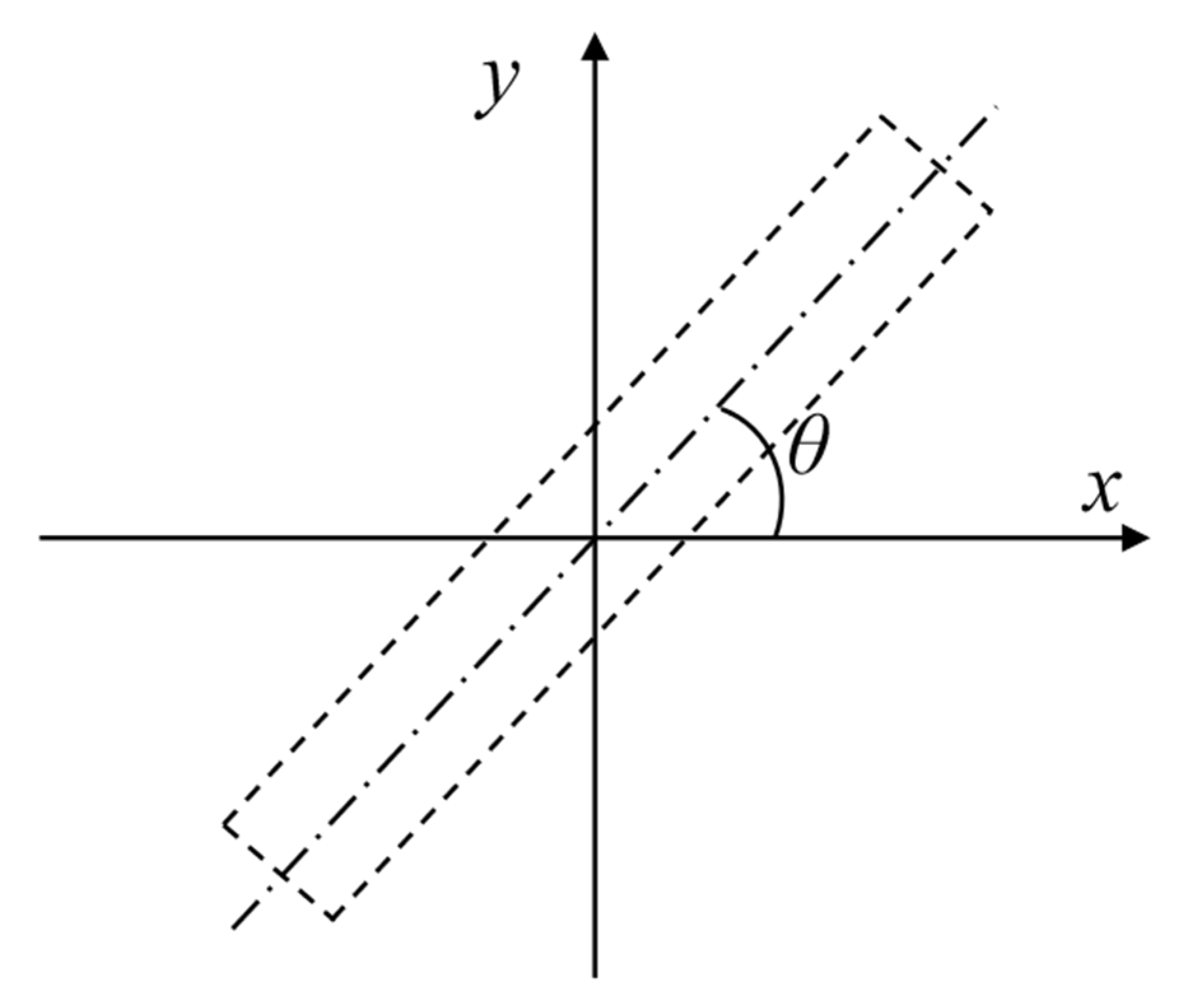
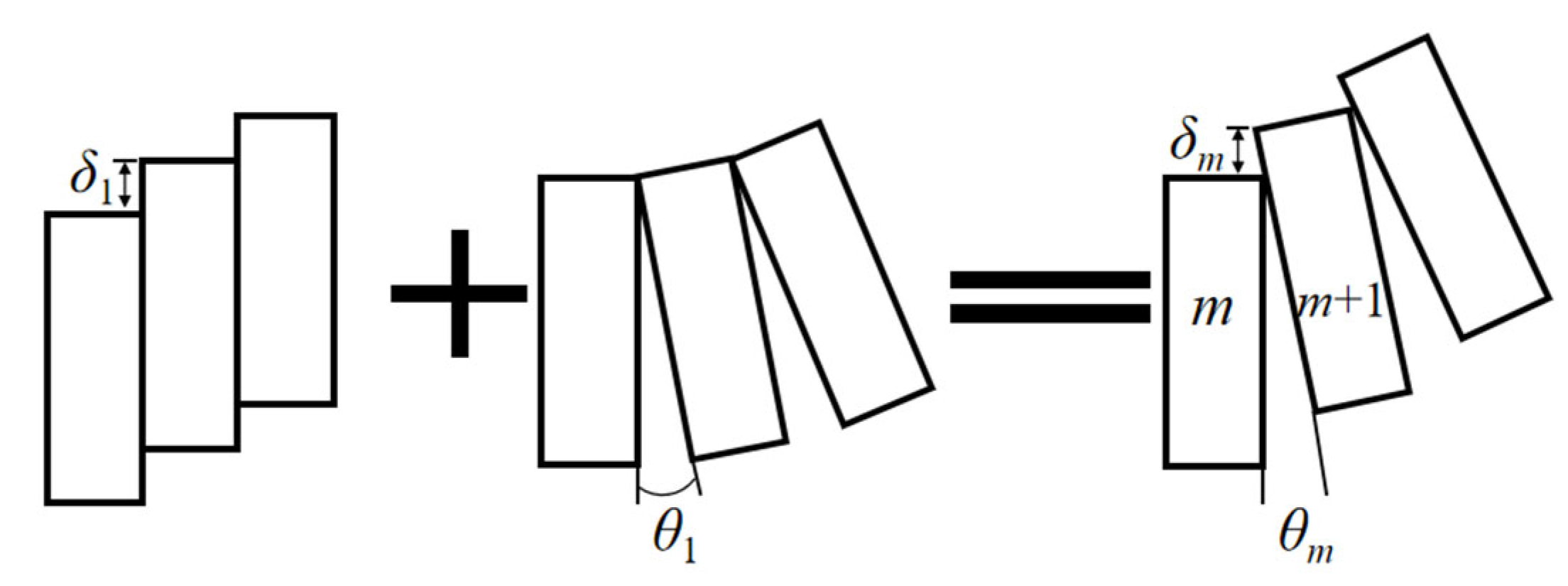
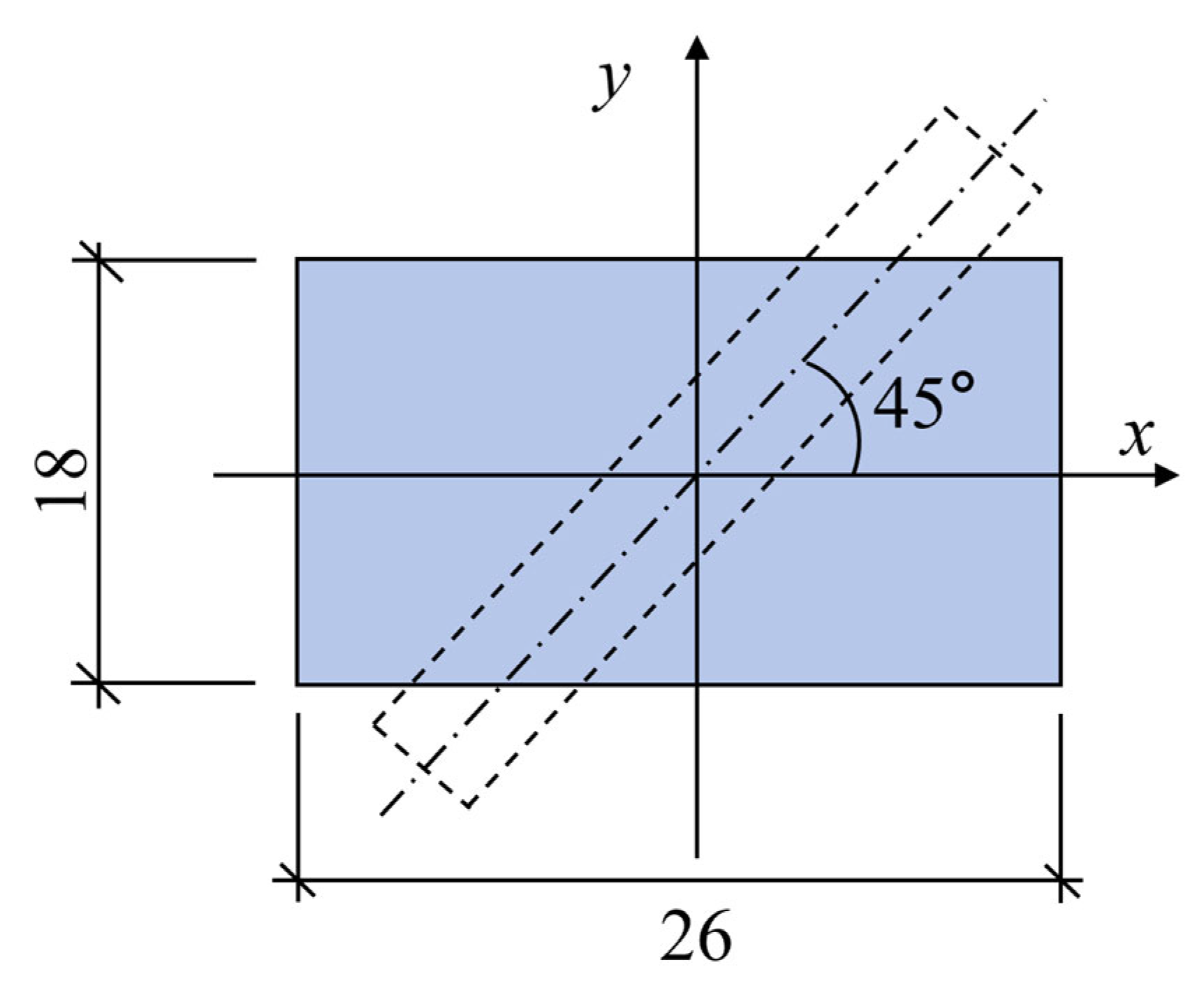


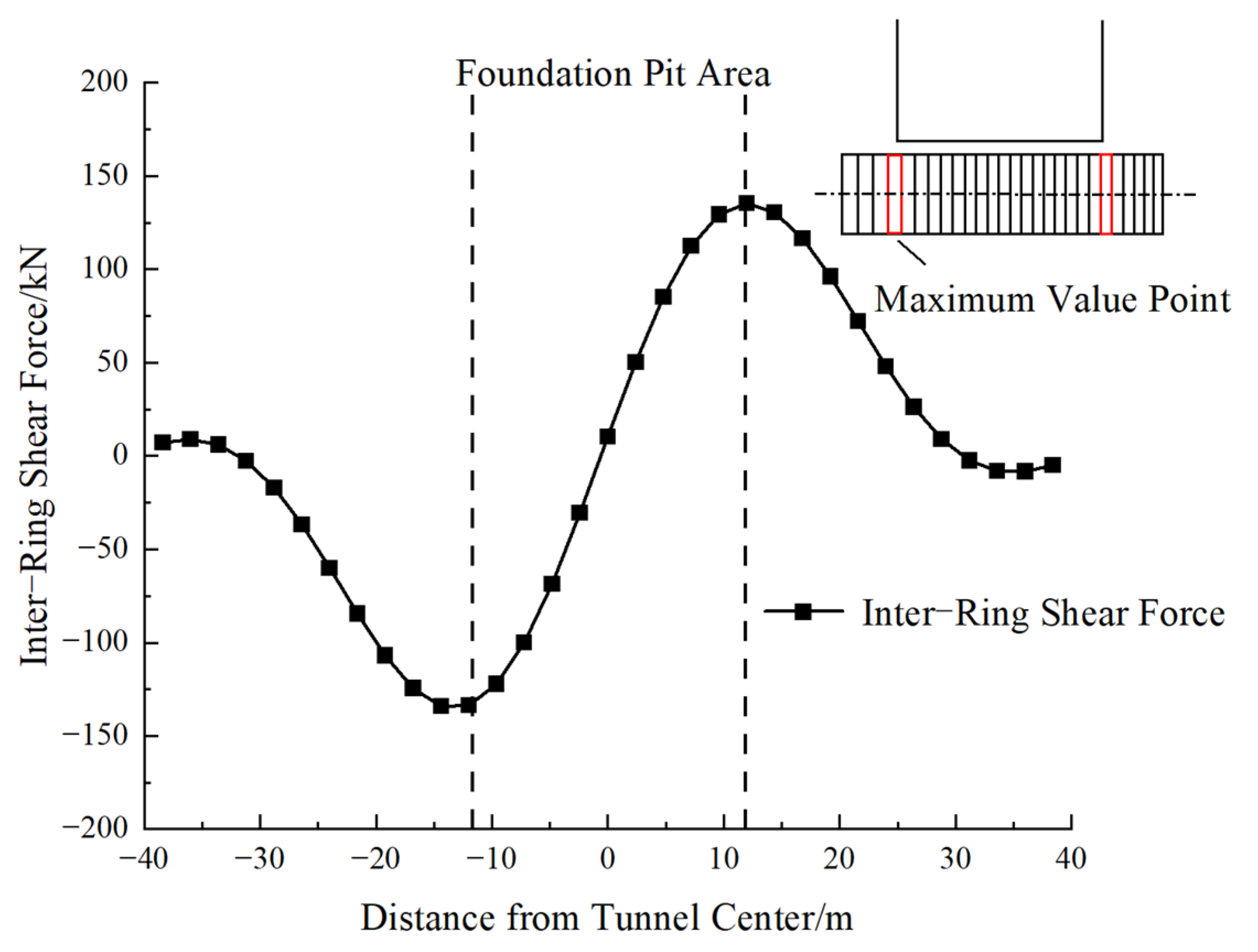

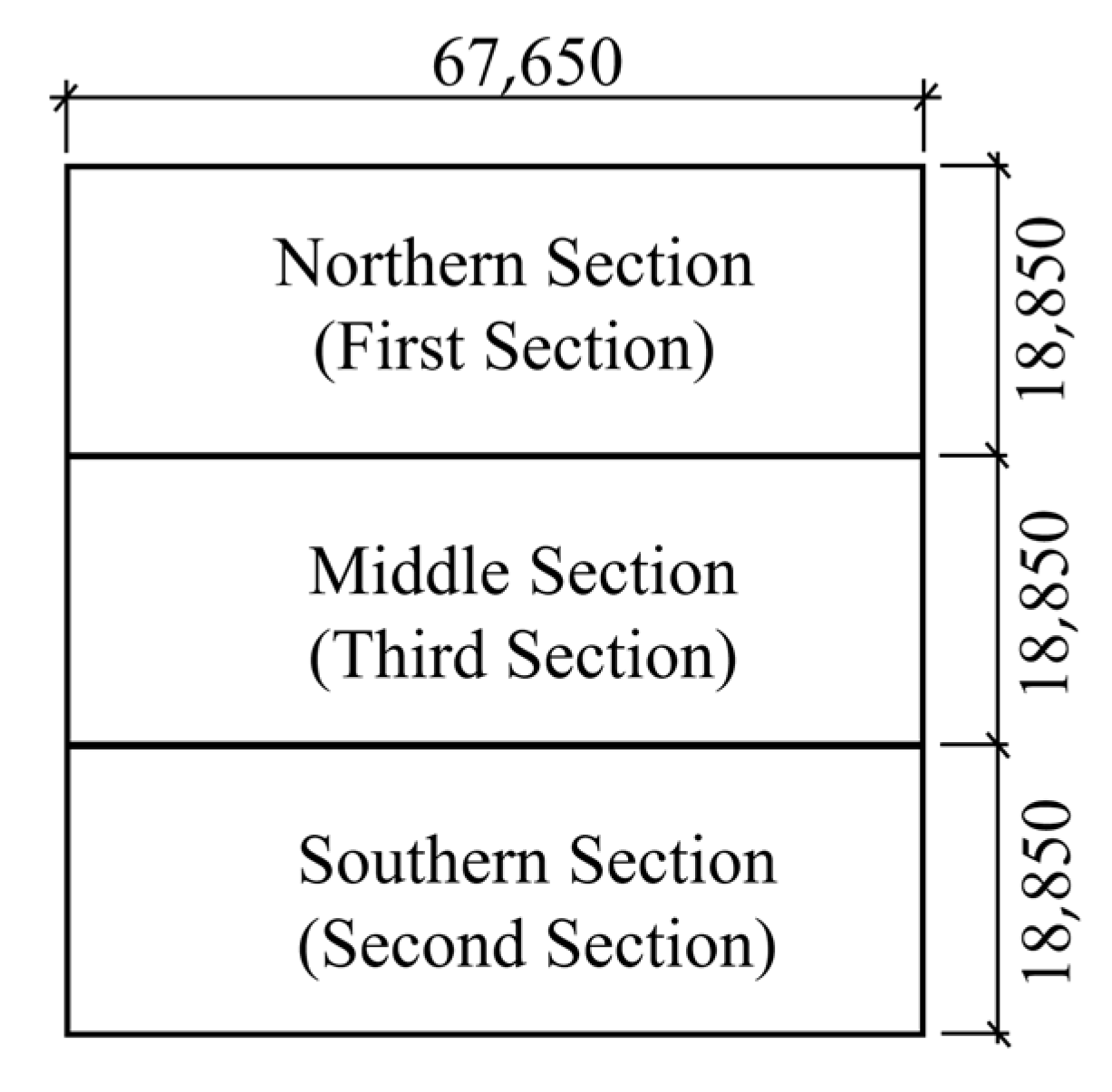
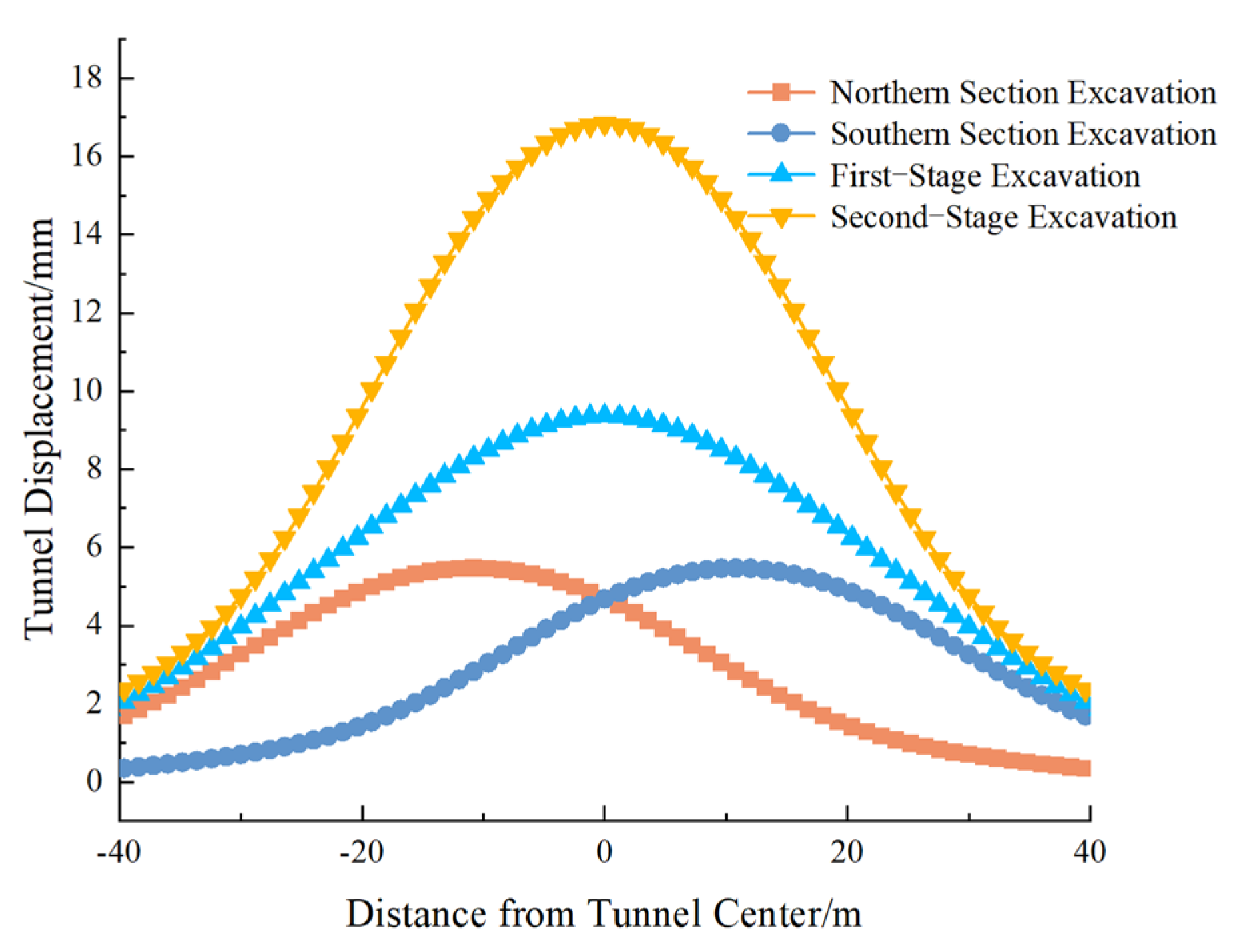



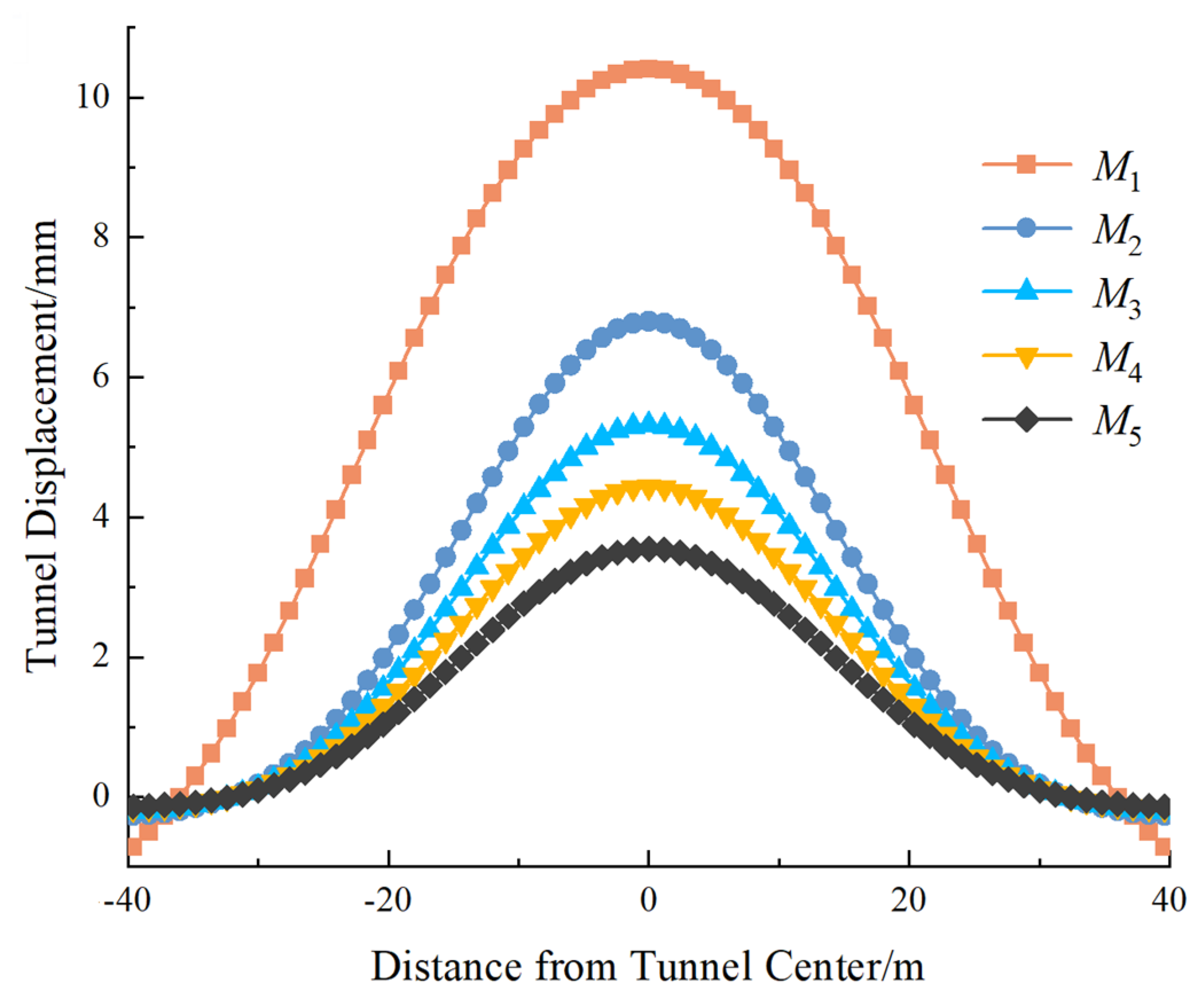
| Soil Layer Number | Soil Layer Name | Layer Thickness/m | Unit Weight/kN·m−3 | Cohesion/kPa | Internal Friction Angle/° | Compression Modulus/MPa |
|---|---|---|---|---|---|---|
| ① | Plain Fill Soil | 1.55 | - | 4.0 | 8.0 | 5.0 |
| ②-1 | Silty Clay | 1.13 | 18.4 | 10 | 28 | 6.43 |
| ②-2 | Silty Clay | 0.82 | 17.7 | 13 | 22 | 3.71 |
| ③-1 | Muddy Clay | 1.08 | 17.7 | 14 | 21.5 | 4.43 |
| ③-2 | Sandy Silt with Interbedded Silty Clay | 2.28 | 18.3 | 3 | 34.5 | 9.72 |
| ③-3 | Muddy Silty Clay | 2.46 | 17.2 | 13 | 20 | 3.63 |
| ④ | Muddy Clay | 8.70 | 16.6 | 14 | 9 | 2.27 |
| ⑤ | Clay | 2.41 | 17.9 | 19 | 13.5 | 4.07 |
| Soil Layer Number | Soil Layer Name | Natural Water Content | Compression Modulus/MPa | Cohesion/kPa | Internal Friction Angle/° | Unit Weight |
|---|---|---|---|---|---|---|
| ① | Plain Fill Soil | - | 5.0 | 4.0 | 8.0 | 3.0 |
| ② | Silty Clay | 30.3 | 5.47 | 22.2 | 14.3 | 3.4 |
| ③ | Interbedded Silty Clay and Silt | 30.9 | 6.46 | 20.1 | 15.5 | 4.3 |
| ④ | Muddy Clay | 43.7 | 3.24 | 15.1 | 9.9 | 5.9 |
| ⑤-1 | Silty Clay | 26.3 | 7.4 | 41.9 | 14.9 | 8.0 |
| ⑤-2 | Silty Clay | 24.9 | 38.8 | 16.2 | 13.2 | 3.6 |
| ⑥ | Gravel | - | 35 | 1 | 38 | 6.7 |
Disclaimer/Publisher’s Note: The statements, opinions and data contained in all publications are solely those of the individual author(s) and contributor(s) and not of MDPI and/or the editor(s). MDPI and/or the editor(s) disclaim responsibility for any injury to people or property resulting from any ideas, methods, instructions or products referred to in the content. |
© 2025 by the authors. Licensee MDPI, Basel, Switzerland. This article is an open access article distributed under the terms and conditions of the Creative Commons Attribution (CC BY) license (https://creativecommons.org/licenses/by/4.0/).
Share and Cite
Wei, G.; Zhou, Y.; Wang, Z.; Wang, Q.; Lu, C.; Feng, G. Deformation Control of Shield Tunnels Affected by Staged Foundation Pit Excavation: Analytical Method and Case Study. Buildings 2025, 15, 2046. https://doi.org/10.3390/buildings15122046
Wei G, Zhou Y, Wang Z, Wang Q, Lu C, Feng G. Deformation Control of Shield Tunnels Affected by Staged Foundation Pit Excavation: Analytical Method and Case Study. Buildings. 2025; 15(12):2046. https://doi.org/10.3390/buildings15122046
Chicago/Turabian StyleWei, Gang, Yebo Zhou, Zhe Wang, Qiaokan Wang, Chenyang Lu, and Guohui Feng. 2025. "Deformation Control of Shield Tunnels Affected by Staged Foundation Pit Excavation: Analytical Method and Case Study" Buildings 15, no. 12: 2046. https://doi.org/10.3390/buildings15122046
APA StyleWei, G., Zhou, Y., Wang, Z., Wang, Q., Lu, C., & Feng, G. (2025). Deformation Control of Shield Tunnels Affected by Staged Foundation Pit Excavation: Analytical Method and Case Study. Buildings, 15(12), 2046. https://doi.org/10.3390/buildings15122046






